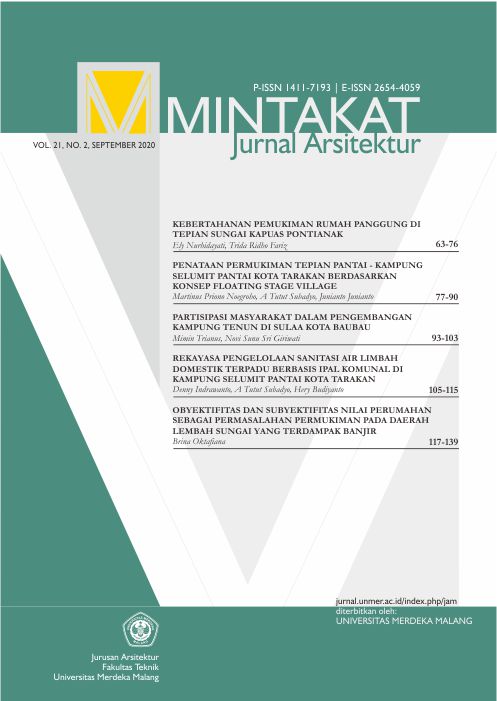KEBERTAHANAN PEMUKIMAN RUMAH PANGGUNG DI TEPIAN SUNGAI KAPUAS PONTIANAK
DOI:
https://doi.org/10.26905/mj.v21i2.4090Keywords:
kerentanan, kebertahanan, pemukiman, rumah panggung, sungai Kapuas.Abstract
Pemukiman di tepian sungai Kapuas Pontianak telah mengalami perkembangan hampir dua setengah abad. Padahal wilayah tepian sungai memiliki kerentanan bencana banjir dan genangan yang paling parah terjadi pada pemukiman yang dekat dengan perairan. Gap penelitian ini adalah orang akan cenderung mencegah, menjauhi dan meninggalkan bermukim di daerah yang rentan bencana. Padahal penelitian sebelumnya menjustifikasi bahwa kebertahanan pemukiman Kampung Beting di tepian sungai Kapuas Pontianak berada pada kategori sangat tinggi. Penelitian ini terletak di Kelurahan Kampung Dalam Bugis dan Kelurahan Tambelan Sampit, Kecamatan Pontianak Timur, Kota Pontianak. Tujuan penelitian ini adalah menghasilkan model kebertahanan pemukiman rumah panggung di tepian sungai Kapuas Pontianak. Sedangkan sasarannya adalah menganalisis kebertahanan pemukiman rumah panggung di Kelurahan Kampung Dalam Bugis dan Kelurahan Tambelan Sampit. Metode penelitian yang digunakan adalah metode kuantitatif dengan pendekatan uji regresi stepwise method, uji anova, dan mendeskripsikan persamaan regresi yang dihasilkan. Teknik sampling yang digunakan adalah cluster sampling berjumlah 200 responden. Adapun variabel kebertahanan yang diukur adalah variabel sosial, ekonomi, masyarakat, dan infrastruktur perumahan. Hasil penelitian antara lain model kebertahanan di Kelurahan Kampung Dalam Bugis dipengaruhi oleh variabel sosial, ekonomi, masyarakat, dan infrastruktur pemukiman. Sedangkan model kebertahanan di Kelurahan Tambelan Sampit dipengaruhi oleh variabel sosial, ekonomi, Sdan infrastruktur pemukiman.
DOI: https://doi.org/10.26905/mj.v21i2.4090
Downloads
References
Angeon, V., & Bates, S. (2015). Reviewing Composite Vulnerability and Resilience Indexes: A Sustainable Approach and Application. World Development, 72, 140–162. https://doi.org/10.1016/j.worlddev.2015.02.011
Bank, W. (2008). Climate Resilient Cities: A Primer on Reducing Vulnerabilities to Climate Change Impacts and Strengthening Disaster Risk Management in East Asian Cities. Policy Paper. https://doi.org/10.1596/978-0-8213-7766-6
BNPB. (n.d.). Definisi dan Jenis Bencana. Retrieved from http://www.bnpb.go.id/pengetahuan-bencana/definisi-dan-jenis-bencana
Cutter, S. L., Ash, K. D., & Emrich, C. T. (2014). The geographies of community disaster resilience. Global Environmental Change, 29, 65–77. https://doi.org/10.1016/j.gloenvcha.2014.08.005
Cutter, S. L., Barnes, L., Berry, M., Burton, C., Evans, E., Tate, E., & Webb, J. (2008). A place-based model for understanding community resilience to natural disasters. Global Environmental Change, 18(4), 598–606. https://doi.org/10.1016/j.gloenvcha.2008.07.013
Daniel, Meddy, M., Stefanus, B., Azwansyah, & Heri. (2005). Penentuan Lokasi Banjir Tertinggi Kota Pontianak Dengan Pendekatan Matematis Linier : Laporan Penelitian. Fakultas Teknik Universitas Tanjungpura.
Daramola, A. Y., Oni, O. T., Ogundele, O., & Adesanya, A. (2016). Adaptive capacity and coping response strategies to natural disasters: A study in Nigeria. International Journal of Disaster Risk Reduction, 15, 132–147. https://doi.org/10.1016/j.ijdrr.2016.01.007
Frazier, T. G., Thompson, C. M., & Dezzani, R. J. (2014). A framework for the development of the SERV model: A Spatially Explicit Resilience-Vulnerability model. Applied Geography, 51, 158–172. https://doi.org/10.1016/j.apgeog.2014.04.004
Hasanuddin. (2015). Sejarah Kota Pontianak Masa Kolonial. Yogyakarta: Ombak.
Hung, H.-C., Yang, C.-Y., Chien, C.-Y., & Liu, Y.-C. (2016). Building resilience: Mainstreaming community participation into integrated assessment of resilience to climatic hazards in metropolitan land use management. Land Use Policy, 50, 48–58. https://doi.org/10.1016/j.landusepol.2015.08.029
Jabareen, Y. (2013). Planning the resilient city: Concepts and strategies for coping with climate change and environmental risk. Cities, 31, 220–229. https://doi.org/10.1016/j.cities.2012.05.004
Joerin, J., Shaw, R., Takeuchi, Y., & Krishnamurthy, R. (2012). Assessing community resilience to climate-related disasters in Chennai, India. International Journal of Disaster Risk Reduction, 1, 44–54. https://doi.org/10.1016/j.ijdrr.2012.05.006
Khailani, D. K., & Perera, R. (2013). Mainstreaming disaster resilience attributes in local development plans for the adaptation to climate change induced flooding: A study based on the local plan of Shah Alam City, Malaysia. Land Use Policy, 30(1), 615–627. https://doi.org/10.1016/j.landusepol.2012.05.003
Khalili, S., Harre, M., & Morley, P. (2015). A temporal framework of social resilience indicators of communities to flood, case studies: Wagga wagga and Kempsey, NSW, Australia. International Journal of Disaster Risk Reduction, 13, 248–254. https://doi.org/10.1016/j.ijdrr.2015.06.009
Kotzee, I., & Reyers, B. (2016). Piloting a social-ecological index for measuring flood resilience: A composite index approach. Ecological Indicators, 60, 45–53. https://doi.org/10.1016/j.ecolind.2015.06.018
Kusumastuti, R. D., Viverita, Husodo, Z. A., Suardi, L., & Danarsari, D. N. (2014). Developing a resilience index towards natural disasters in Indonesia. International Journal of Disaster Risk Reduction, 10(PA), 327–340. https://doi.org/10.1016/j.ijdrr.2014.10.007
Nurhidayati, E., Imam Buchori., and Mussadun. 2016. The Water Based Urban Development in Pontianak: A Review The History of Riverine Settlements. The 1st Geoplanning International Conference.
Nurhidayati, E., Imam Buchori., and Mussadun, 2016. Prediksi Perkembangan Lahan Permukiman Terhadap Kerentanan Bencana Banjir dan Kebakaran di Permukiman Tepian Sungai Kapuas Kota Pontianak. Jurnal Tata Loka. Volume 18 (No 4): 249-260.
Nurhidayati, E. 2016. The Resilience of Rumah Panggung's Settlements in the Kapuas Riverbanks of Pontianak. 5Th International Conference in Urban Heritage and Sustainable Infrasctructure Development.
Poerwoningsih, D., Santoso,I., Laksmiani, E. (2018). Konsep Bioregion Dalam Pengelolaan Sumberdaya Lansekap Arsitektur Nusantara. Mintakat Jurnal Arsitektur, 19(1). 49-58.
U.S. National Research Council. (2010). Adapting to the Impacts of Climate Change.
Usamah, M., Handmer, J., Mitchell, D., & Ahmed, I. (2014). Can the vulnerable be resilient? Co-existence of vulnerability and disaster resilience: Informal settlements in the Philippines. International Journal of Disaster Risk Reduction, 10, 178–189. https://doi.org/10.1016/j.ijdrr.2014.08.007
Usamah, M., Handmer, J., Mitchell, D., & Ahmed, I. (2014). Can the vulnerable be resilient? Co-existence of vulnerability and disaster resilience: Informal settlements in the Philippines. International Journal of Disaster Risk Reduction, 10, 178–189. https://doi.org/10.1016/j.ijdrr.2014.08.007














